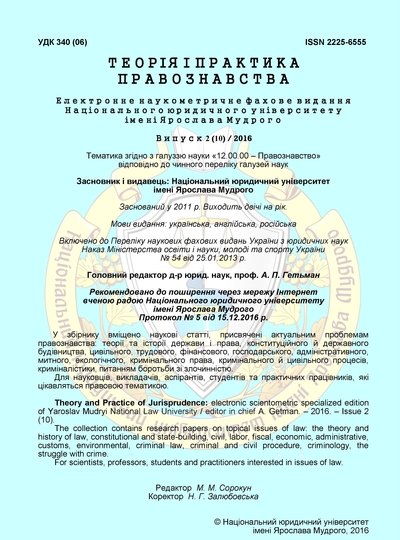The principle of the closest connection to the modern international private law
DOI:
https://doi.org/10.21564/2225-6555.2016.10.86692Keywords:
lex connection is fermitatis, the law of the real connection, collision principle, contractual liability in international private law, Rom ConventionAbstract
The article is devoted to the concept of the closest connection to private international law. This article examines the historical background of the formation of the phenomenon and its closest connection and attachment as a formula and as a principle to international law statute. It is well known that using the closest connection means the application of the private law of the country which is most closely connected with the foreign element. In essence the closest connection criteria is abstract and may vary fundamentally in different ways. Thus the search for objective criteria for law to be applied is based on the approach outlined in doctrine by F. Savigny, whose name is traditionally associated with a concept of flexible conflict law. According to F. Savigny, when establishing the applicable law, finding a legal relationship for each legal sphere, which belongs to legal relationships by nature, takes place.
The basic concept for the application of this phenomenon in contractual and non-contractual relationships was analyzed. A group of main criteria of relationships in close connection with a particular legal law were studied. The basic rules of international agreements and domestic laws that reflect the criteria and close links with the contractual relationship were developed. The rules were taken from the Rome Convention on the law applicable to contractual obligations 1980.
The paper emphasises that in the modern private international law the closest connection traditionally understood as a formula of attachment that forms a flexible choice of law rules and conflict of law principle. The flexibility of this concept is based on the lack of clear criteria for determining the closest connection of legal relationship and nomocracy, often considered a significant drawback of such a formula of attachment. However the lack of clear criteria can also be considered as a positive feature of the closest connection and it’s usage increases. The flexibility of the principle of the closest connection contributes the most appropriate legal regulation of public relations. The conflict rules based on this principle are not the subject to aging.
References
Garmatskiy, E. (2011). Problema mobilnogo konfliktu u mizhnarodnomu privatnomu pravi. Pidpriemnitstvo, gospodarstvo i pravo, 5, 62–64 [in Ukrainian].
Dovgert, A.S. Zakonodavstvo Ukrayini z mizhnarodnogo privatnogo prava: Dzherela zapozichennya. Teoretiko-metodologichni pidhodi do rozumInnya privatnogo prava v suchasnih umovah. irbis-nbuv.gov.ua. Retrieved from irbis-nbuv.gov.ua/.../cgiirbis_64.exe? [in Ukrainian].
Erpyileva, N.Yu., Batler U.E. (2007). Kollizionnyie normyi v mezhdunarodnom chastnom prave Rossii i Ukrainyi. Gosudarstvo i pravo, 7, 84–91 [in Russian].
Kisil, V.I. (2005). MIzhnarodne privatne pravo: pitannya kodifikatsiyi. Kyiv: Ukrayina.
Kudashkin, V. Pravovoe regulirovanie mezhdunarodnyih chastnyih otnosheniy. books.google.com.ua Retrieved from https://books.google.com.ua/books?isbn=5040068492 [in Russian].
Mezhdunarodnoe chastnoe pravo. rutlib.com. Retrieved from http://rutlib.com/book/6600/p/23 [in Russian].
Stepanyuk, A. (2005). Fenomen naybilsh tisnogo zvyazku u mizhnarodnomu privatnomu pravi. Visnik Akad. prav. nauk Ukrayini, 1 (40), 107–116 [in Ukrainian].
Downloads
How to Cite
Issue
Section
License
Copyright (c) 2016 Theory and practice of jurisprudence

This work is licensed under a Creative Commons Attribution 4.0 International License.




